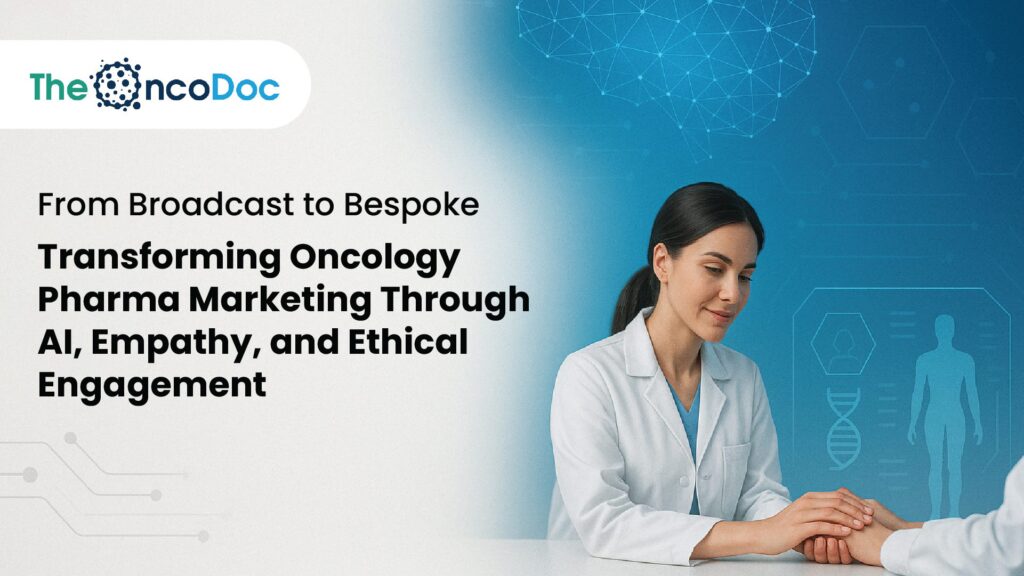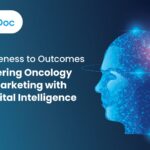Introduction: Rethinking Pharma’s Role in the Oncology Journey
In a landscape as emotionally charged and scientifically complex as oncology, the traditional playbook of pharmaceutical marketing no longer resonates. Today’s oncologists aren’t just prescribers; they are information gatekeepers, patient advocates, and research collaborators. In such an environment, bombarding them with promotional content is not just ineffective; it’s tone-deaf.
Pharma marketers must transition from product-first communication to relationship-first engagement. As oncology becomes increasingly personalized, so must the way it is marketed. Enter the new era of bespoke digital marketing, powered by AI, behavioral science, ethical frameworks, and a deep understanding of human needs.
Gone are the days when field force interactions or conference booths sufficed. The modern oncologist operates in a fast-evolving clinical environment and is looking for trusted knowledge partners, not product pushers. In this reality, the success of pharma engagement hinges on building enduring relationships rooted in relevance, respect, and responsiveness.
This article explores how pharma companies can reinvent their oncology strategies to offer precision engagement rather than passive exposure,earning the trust of healthcare professionals (HCPs) and empowering better outcomes for patients.
Part 1: The Oncology Marketing Shift-From Awareness to Advocacy
Why the Old Model No Longer Works
For decades, pharma marketing followed a broadcast model, disseminating one-size-fits-all messages through print ads, sales representatives, speaker events, and sponsorships. These channels, while still relevant in some contexts, are losing ground due to digital saturation, evolving physician behavior, and rising regulatory scrutiny.
Today’s oncologists face information overload, time scarcity, and increased skepticism toward commercial narratives. Their digital literacy is high, and their expectations for value-added content are higher. What they seek is not volume, but clinical substance and credibility.
Key factors eroding the effectiveness of traditional models:
- Saturation of promotional content across digital platforms
- Decreased face-to-face access to physicians due to compliance and post-COVID restrictions
- Greater reliance on peer-reviewed, evidence-backed material
- Time poverty among oncologists makes them highly selective with digital engagement
Building Beyond Transactions
The future of pharma marketing lies in fostering HCP advocacy, not merely increasing brand awareness. Advocacy is built when an oncologist:
- Proactively recommends a treatment or brand based on clinical merit
- Feels confident in the evidence, safety profile, and real-world efficacy
- Believes in the scientific and ethical integrity of the manufacturer
This level of advocacy can only be achieved through ongoing trust, educational value, and meaningful collaboration. Brands must shift from monologues to dialogues: from delivering content to co-creating relevance.
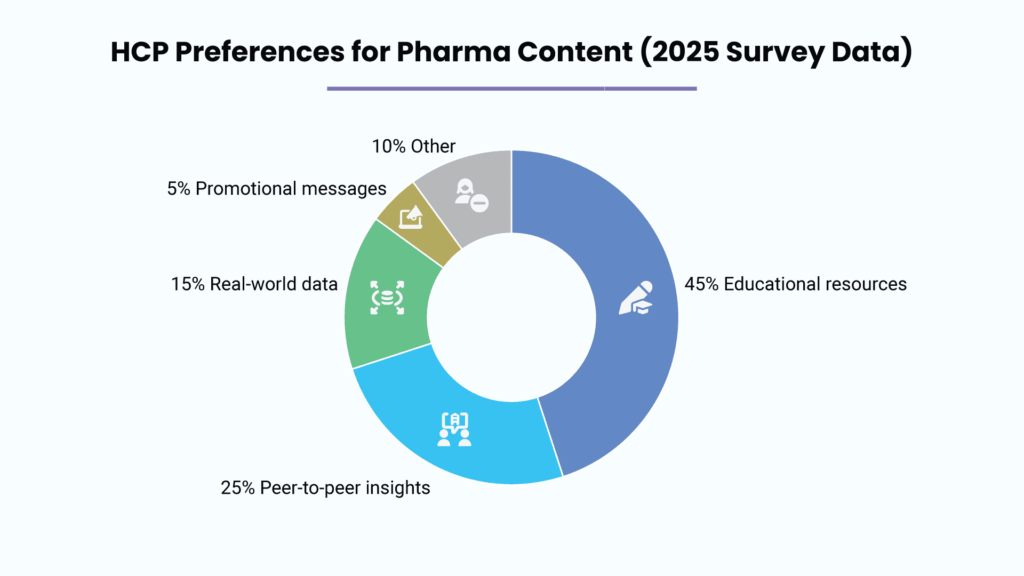
The above data from a 2025 India-wide oncology survey reveals that most oncologists prioritize educational resources and peer insights over promotional material. This clearly underscores the importance of delivering clinically enriching experiences.
Part 2: Personalization at Scale-Using AI to Tailor HCP Engagement
The Rise of AI-Enabled Omnichannel Marketing
Artificial Intelligence (AI) has opened new frontiers in healthcare engagement, especially in oncology where information needs are highly specialized. Through AI-driven tools, pharma marketers can now move from static segmentation to fluid, behavior-based personalization.
Machine learning models analyze HCP behavior across touchpoints, from website clicks and webinar participation to email engagement and mobile app usage. These patterns allow marketers to anticipate needs and tailor content delivery by specialty, treatment area, geography, or even preferred time of day.
Benefits of AI in oncology marketing include:
- Dynamic personalization based on evolving clinical interests
- Predictive modeling to deliver content precisely when it’s needed
- Sentiment analysis to refine messaging tone and timing
- Adaptive retargeting to re-engage with value, not frequency
Case Study: Personalization in Action
A global pharma brand launched a digital oncology campaign in India using AI tools to classify oncologists into behavioral clusters. It identified that medical oncologists in metros preferred long-form research PDFs, while community-based practitioners engaged more with regional language videos. After adjusting content accordingly, click-through rates jumped by 23%, and webinar participation increased by 41%.
Moving from Static CRM to Dynamic HCP Profiles
A conventional CRM captures demographic and professional data. However, modern platforms must evolve into living profiles that update with every engagement.
Components of a dynamic HCP profile:
- Clinical focus areas (e.g., breast, lung, GI, hematologic cancers)
- Preferred learning modes (e.g., podcasts, videos, infographics)
- Participation in prior campaigns, webinars, or surveys
- Engagement sentiment and responsiveness history
Such profiles empower marketers to move beyond guesswork,creating micro-personalized journeys rather than pushing generalized content.
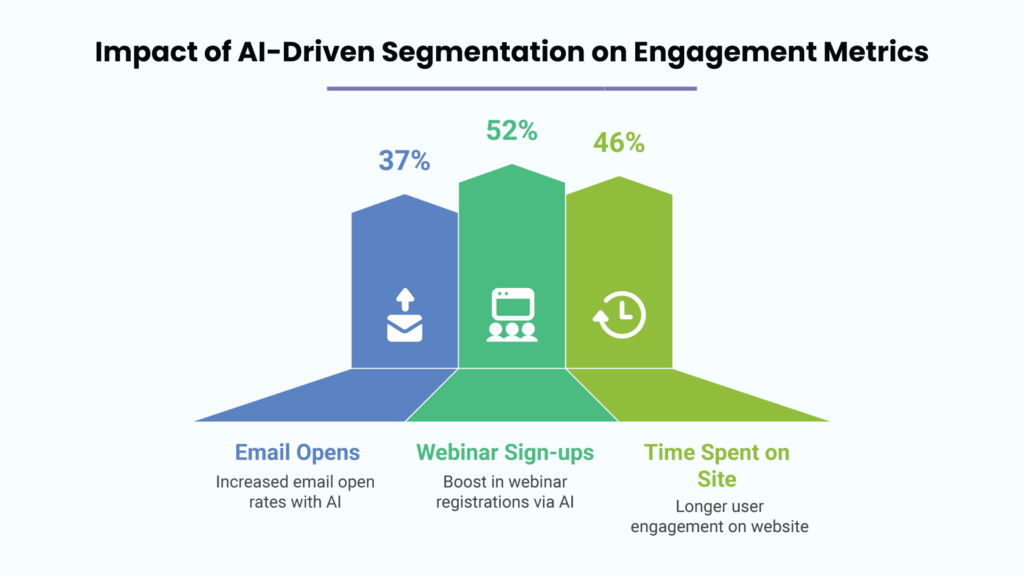
This chart highlights that AI-enhanced strategies can dramatically improve ROI across multiple engagement metrics.
Part 3: Humanizing the Digital Experience-The Role of Empathy and Design
Designing for Cognitive Load and Emotional Context
Oncology is not just scientifically complex; it’s emotionally intense. HCPs face constant decision-making stress, diagnostic uncertainties, and patient-family expectations. In this high-stakes environment, simplifying the digital experience is an act of empathy.
Empathetic UX design involves:
- Bite-sized content (2–3 minute reads or videos)
- Mobile-first layouts for accessibility on the go
- Visual summaries like infographics and decision trees
- Voice search and vernacular content for regional practitioners
Respecting cognitive bandwidth increases engagement and reduces drop-off. It also positions the brand as a support system, not a sales channel.
Making Content That Matters
“Content fatigue” is real; and only the most relevant assets will break through. HCPs are looking for:
- CME-accredited learning modules based on latest trial data
- Digestible breakdowns of treatment algorithms
- Patient case simulations with interactive decision points
- Updates on reimbursement policies or access pathways
- Localized content relevant to Indian clinical practices
By focusing on these areas, pharma companies can ensure their messaging feels more like clinical assistance and less like commercial persuasion.
Part 4: Co-Creation with Oncologists-Empowering the Influencers
Partnering with DOLs, Not Just KOLs
Digital Opinion Leaders (DOLs); physicians who actively shape online discourse—are increasingly influential. Unlike traditional KOLs who may speak at conferences, DOLs engage in real-time, frequent, and contextual dialogue with peers.
How to ethically engage DOLs:
- Invite them to lead knowledge-sharing sessions
- Collaborate on content (blogs, videos, case reviews)
- Involve them in platform beta-testing or product feedback loops
- Enable but do not script their voice; authenticity is key
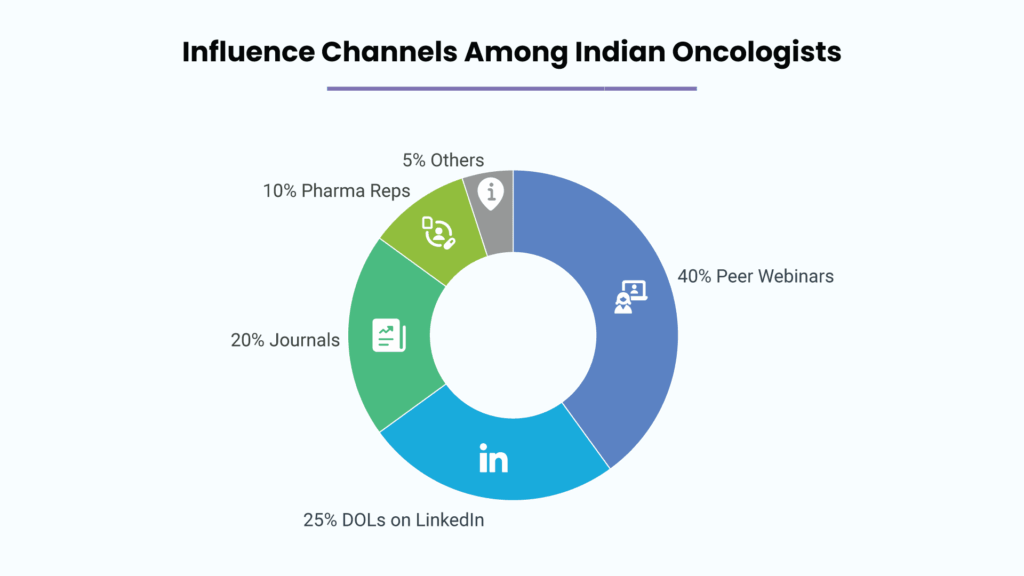
The above data confirms that oncologists now trust peer-led digital platforms more than traditional sales channels.
Community-Led Advocacy
Co-creation extends to the community level. Brands can empower oncology communities by:
- Sponsoring regional tumor boards without branding overload
- Supporting DOL-led WhatsApp learning circles
- Offering grant-backed hybrid CME events
This builds long-term equity by allowing the brand to blend into the clinical ecosystem rather than dominate it.
Part 5: Real-World Evidence as a Storytelling Tool
Bridging Clinical Trials and Day-to-Day Practice
RCTs are the gold standard, but their applicability to real-world practice can be limited. RWE helps clinicians understand how therapies perform in diverse patient populations, especially in India where socioeconomic and demographic variables are vast.
Ways to use RWE in marketing:
- Highlight treatment impact across different age groups or comorbidities.
- Show adherence and persistence trends over time
- Use animated dashboards to present safety and efficacy outcomes
Narrative storytelling (e.g., anonymized patient journeys, audio-visual case diaries) makes data feel relevant and human, not just statistical.
Part 6: Precision Ethics Maintaining Integrity in Digital Pharma
Transparent, Ethical Marketing in India and Beyond
As digital marketing expands, so does scrutiny. In India, regulators are enforcing UCPMP more seriously, especially concerning HCP incentivization and undisclosed sponsorships.
Ethical marketing principles include:
- Clearly labeling sponsored content
- Referencing all claims with peer-reviewed sources
- Disabling data tracking unless consented
- Avoiding coercive nudging tactics (e.g., urgency buttons in educational content)
Ethics is not just compliance -it’s a differentiator. Companies known for clinical integrity are more likely to gain trusted HCP access and peer endorsements.
The Ethics of AI Use
AI must serve as a clinical companion, not a marketing manipulator.
- Audit AI recommendations for fairness and transparency
- Disclose AI-based profiling when personalizing emails or banners
- Avoid aggressive targeting based on patient load or prescribing behavior
By being upfront about AI’s role, pharma can create a safe space for digital adoption among skeptical clinicians.
Part 7: Measuring What Matters—KPIs That Reflect Relationships, Not Reach
Moving Beyond Vanity Metrics
Success is no longer defined by open rates or downloads. Instead, forward-thinking pharma teams are tracking:
- Engagement depth: Time on platform, scroll depth, interaction types
- Knowledge retention: Post-webinar quizzes, case study applications
- Therapy confidence: Self-reported readiness to adopt a new treatment
- Peer sharing: Whether HCPs forward, post, or recommend content
Modern platforms like IQVIA, Adobe Experience Cloud, and Veeva Pulse now allow pharma to correlate these metrics with HCP intent and advocacy, not just exposure.
Conclusion: The Future Is Collaborative, Curated, and Clinically Meaningful
In an era where every click is a conscious choice, pharma marketers must stop broadcasting and start co-authoring. In oncology; where decisions often carry the weight of life or death, the role of marketing must be redefined from persuasion to partnership.
Reimagining pharma marketing means embracing
- AI for precision,not manipulation
- Design thinking grounded in empathy
- Storytelling built on real-world impact
- Ethics as the foundation of influence
Marketers who internalize this paradigm will no longer fight for attention; they will be invited into the oncology care journey. And that’s where real, lasting impact begins-not in slogans, but in shared success stories.
The Oncodoc team is a group of passionate healthcare and marketing professionals dedicated to delivering accurate, engaging, and impactful content. With expertise across medical research, digital strategy, and clinical communication, the team focuses on empowering healthcare professionals and patients alike. Through evidence-based insights and innovative storytelling, Hidoc aims to bridge the gap between medicine and digital engagement, promoting wellness and informed decision-making.

